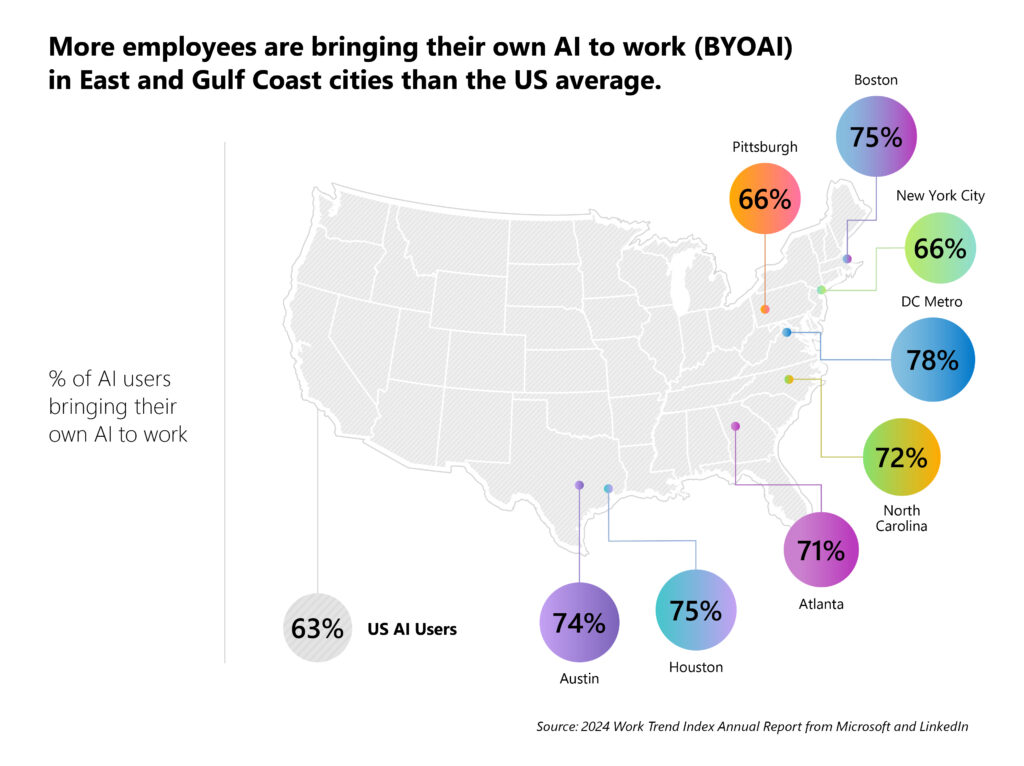
AI leadership: Elevating productivity, privacy, and security
This spring, Microsoft and LinkedIn surveyed 31,000 people around the globe about their workplace experience, with a focus on AI in the workplace. The results, which formed the 2024 Work Trend Index Annual Report (WTI), revealed that AI at work is already here. For the first time, this year’s WTI features insights from several key business markets across the United States East and Gulf Coasts. This provides a unique perspective on the application and future of AI in a region that encompasses a diverse range of industries, with lessons that are relevant far beyond these areas.
For business leaders, this report lets you gain insights from talent and decision makers in Boston, New York City, Pittsburgh, the DC Metro area, North Carolina, Atlanta, Houston, and Austin. These folks echoed Microsoft’s global findings:
- Employees want AI at work — and won’t wait for companies to catch up
- AI raises the bar and breaks the career ceiling for employees
- The rise of the AI power user — and what they reveal about the future
These local findings also surfaced a meaningful lesson: by leading on AI, organizations can enhance productivity, privacy, and security. Data shows that talent in the East and Gulf Coast is eager for AI, with the region already hosting AI power users. For business leaders here, creating an organizational plan for AI ensures your business is getting the most out of this new technology while also creating an environment that keeps up with the desires and expectations of your local talent base.
As the report’s key learnings demonstrate, employees in these markets want AI at work and they’re not waiting for their companies to catch up. In fact, employees in these areas are bringing their own AI to work (BYOAI) at a higher rate than the national average. This enthusiasm for AI is a tremendous opportunity – and business leaders who delay integrating AI into their operations risk falling behind.

Strategy breeds productivity
Strategically providing employees with AI tools enhances productivity. When employees BYOAI, they take it upon themselves to explore which tools meet their needs and learn on-the-go how to use them. This takes time away from their work, may not provide the best tools for their tasks, and may lead to inconsistent results across employees using different tools.
On the other hand, when a business purposefully brings in AI tools tailored to employees’ work, it allows leaders to incorporate training on those tools, and it allows employees to lean on each other to share best practices and lessons learned as they apply it in their everyday roles.
This highlights the importance of collaboration for AI power users in the region:


Taken together, investing in employee AI training can nurture power users willing to innovate how they use these tools to advance their work while fostering collaboration with their colleagues.
Aligning security and privacy with AI at work
Productivity aside, BYOAI can leave organizations vulnerable to lapses in their security and privacy standards. This is meaningful considering that the number one concern leaders expressed for the year ahead – around the world – is cybersecurity and data privacy.
Having worked with dozens of customers from across a range of industries and numerous Microsoft teams to create security solutions, I’ve seen firsthand how important these standards are to every business and the customers they serve. By using BYOAI technologies that don’t adhere to those standards, companies are open to financial losses, reputational damage, and legal liabilities. Moreover, it can undermine the trust and confidence that are essential for effective collaboration and innovation.
For more insights on securing the generative AI your teams use and build, check out this post on securing generative AI with Microsoft Security.
Making a plan
As with any tech transformation, it can feel overwhelming to choose a path forward on AI at work and take action. In most East and Gulf Coast markets, at least half of all leaders worry that their organization’s leadership lacks a plan and vision to implement it.
WTI data shows that leaders know they need to make a plan; across the East and Gulf Coasts, leaders recognize the need for AI action.
- 77% of US business leaders believe their company needs to adopt AI to remain competitive.
- More than three-fourths of leaders in Austin, Boston, North Carolina, and Washington, DC share that sentiment, while leaders in Atlanta and New York City both exceed the national average. (80% and 88%, respectively).
- Around 50% or more of leaders in every East and Gulf Coast market expressed concerns that their leadership teams lack the vision and plan to implement AI in their organizations.
Every day, employees across the East and Gulf Coasts—and around the world—explore how to use AI to address their job-specific challenges and bring creativity to their field. But it’s still early days: Many employees just began experimenting with using AI at work within the last six months.
Leaders who step up now will shape how their organization fosters employee productivity while embracing an ecosystem that addresses data and privacy concerns.
For more insights on how to accelerate AI adoption through leadership, check out Sydne Mullings’s latest post.
Methodology
Work Trend Index Survey
The Work Trend Index survey was conducted by an independent research firm, Edelman Data & Intelligence, among 31,000 full-time employed or self-employed knowledge workers across 31 markets between February 15, 2024 and March 28, 2024. This survey was 20 minutes in length and conducted online, in either the English language or translated into a local language across markets. One thousand full-time workers were surveyed in each market, and global results have been aggregated across all responses to provide an average. In the US, an additional sample of 2,800 full-time employed or self-employed knowledge workers was collected across nine sub-regions/metros.
Global markets surveyed include: (sample size average 1,000 per market)
Argentina, Australia, Brazil, Canada, China, Colombia, Czech Republic, Finland, France, Germany, Hong Kong, India, Indonesia, Italy, Japan, Malaysia, Mexico, Netherlands, New Zealand, Philippines, Poland, Singapore, South Korea, Spain, Sweden, Switzerland, Taiwan, Thailand, United Kingdom, United States, and Vietnam.
Sub-regions/Metros in the United States surveyed include:
Atlanta (n:300), Austin (n:200), Boston (n:350), DC Metro (n:250), Houston (n:300), New York City (n:400), North Carolina (n:300), Pittsburgh (n:200), and the San Francisco Bay Area (n:500).




